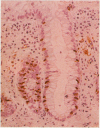Abstract
Previous studies have shown the presence of increased proliferation in the large bowel epithelium of those at high risk of developing colon cancer. An in vitro technique for labelling large bowel mucosa with the thymidine analogue bromodeoxyuridine (Brdu) was therefore developed and its ability to distinguish differences in mucosal proliferation between subjects with colorectal adenomas and normal controls was assessed. Sigmoid biopsy specimens from 15 subjects with polyps and 15 age and sex matched controls were labelled and the incorporated Brdu visualised with an immunohistochemical technique. Mean labelling index (LI) was significantly higher in those with polyps than in controls. Differences in the pattern of labelling in colonic crypts were compared by the generation of cumulative labelling distributions. Analysis showed a significant expansion of the proliferative compartment in the colon crypts of those with polyps. It is concluded that in vitro labelling with Brdu provides a useful method for the assessment of mucosal proliferation in subjects at high risk of developing colon cancer.
Full text
PDF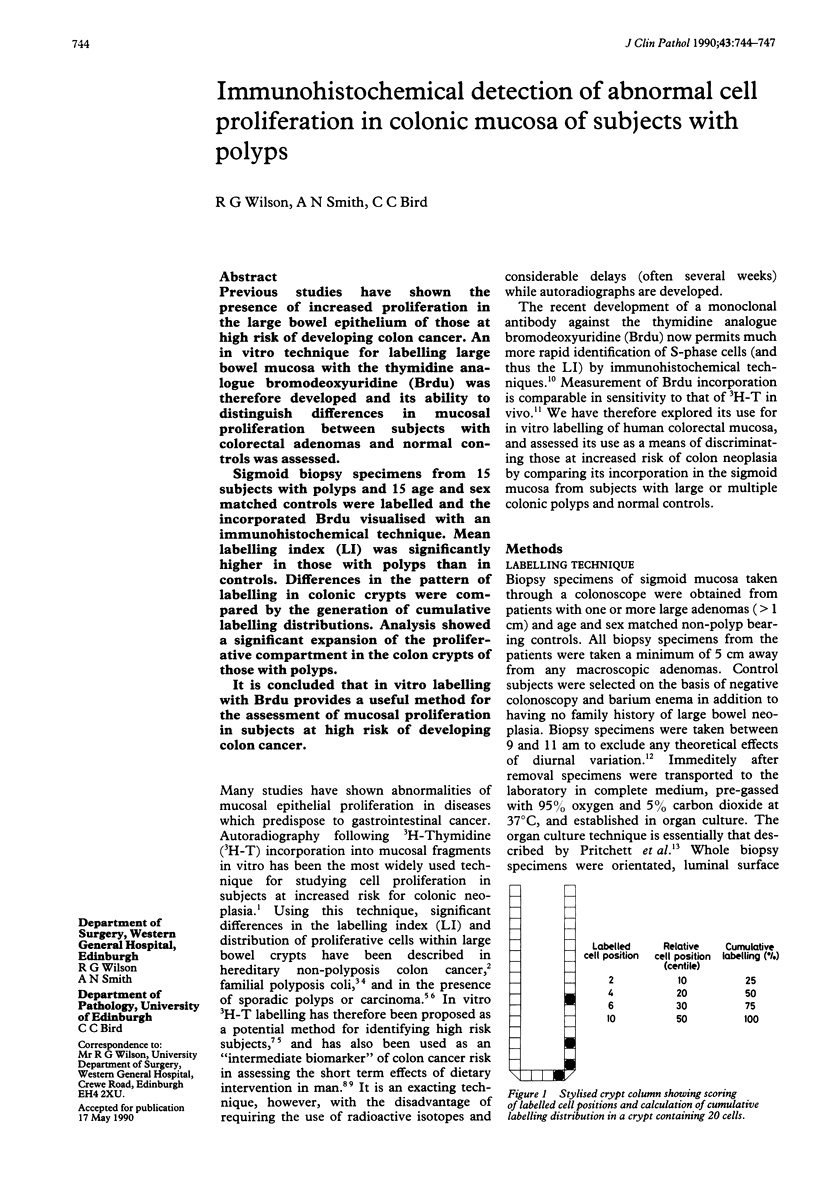
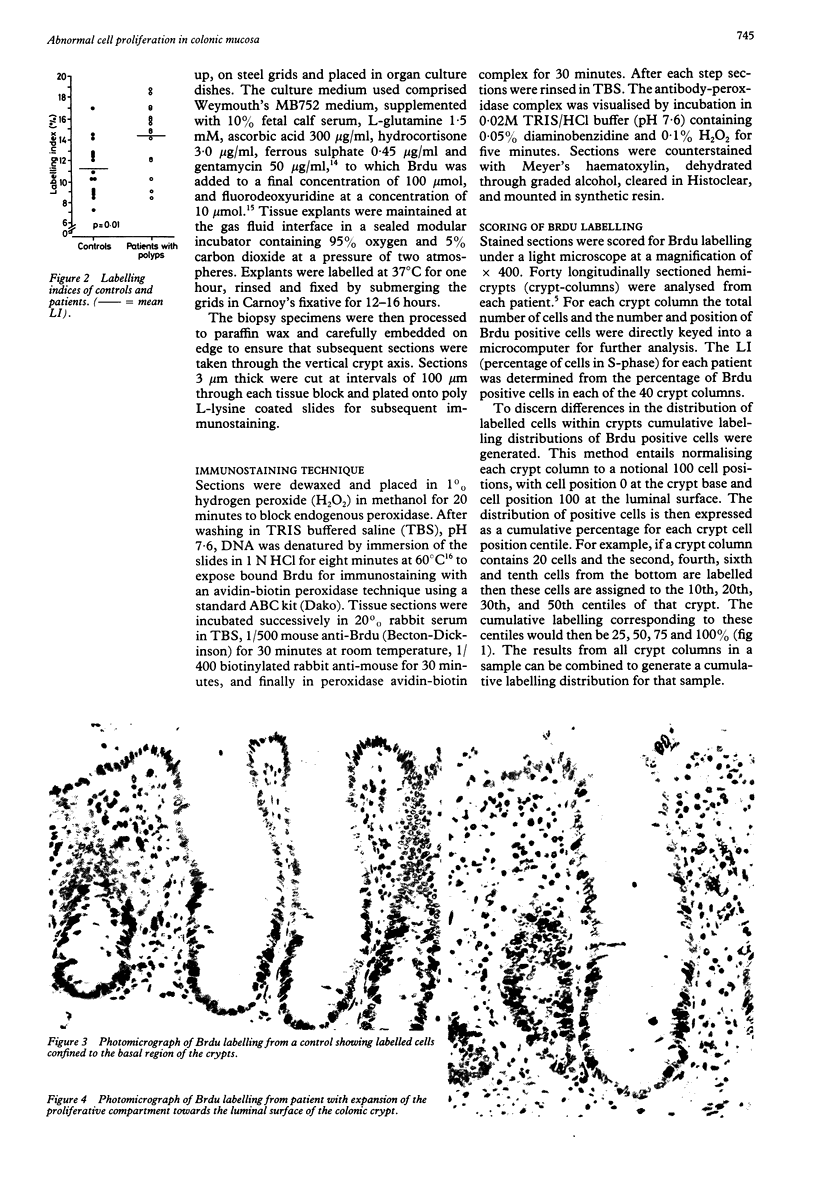
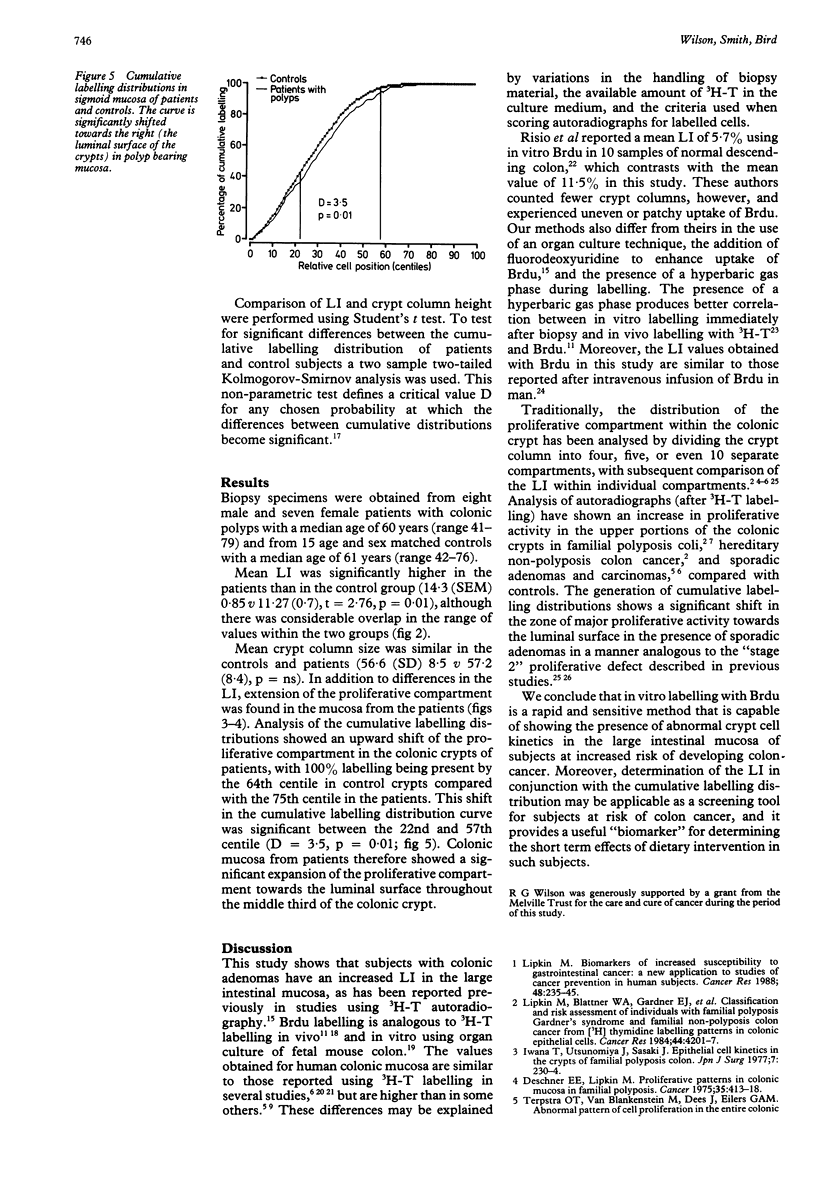
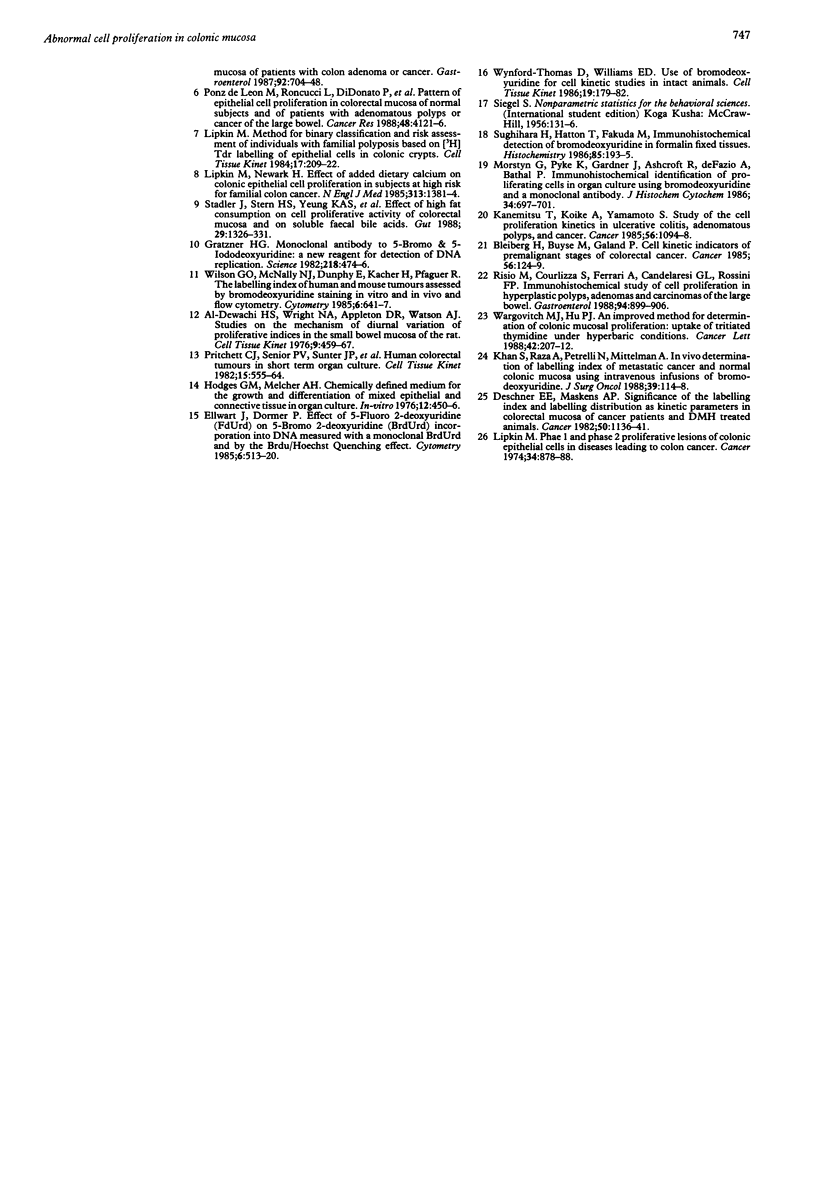
Images in this article
Selected References
These references are in PubMed. This may not be the complete list of references from this article.
- Al-Dewachi H. S., Wright N. A., Appleton D. R., Watson A. J. Studies on the mechanism of diurnal variation of proliferative indices in the small bowel mucosa of the rat. Cell Tissue Kinet. 1976 Sep;9(5):459–467. doi: 10.1111/j.1365-2184.1976.tb01296.x. [DOI] [PubMed] [Google Scholar]
- Bleiberg H., Buyse M., Galand P. Cell kinetic indicators of premalignant stages of colorectal cancer. Cancer. 1985 Jul 1;56(1):124–129. doi: 10.1002/1097-0142(19850701)56:1<124::aid-cncr2820560119>3.0.co;2-y. [DOI] [PubMed] [Google Scholar]
- Deschner E. E., Lipkin M. Proliferative patterns in colonic mucosa in familial polyposis. Cancer. 1975 Feb;35(2):413–418. doi: 10.1002/1097-0142(197502)35:2<413::aid-cncr2820350217>3.0.co;2-b. [DOI] [PubMed] [Google Scholar]
- Deschner E. E., Maskens A. P. Significance of the labeling index and labeling distribution as kinetic parameters in colorectal mucosa of cancer patients and DMH treated animals. Cancer. 1982 Sep 15;50(6):1136–1141. doi: 10.1002/1097-0142(19820915)50:6<1136::aid-cncr2820500617>3.0.co;2-a. [DOI] [PubMed] [Google Scholar]
- Ellwart J., Dörmer P. Effect of 5-fluoro-2'-deoxyuridine (FdUrd) on 5-bromo-2'-deoxyuridine (BrdUrd) incorporation into DNA measured with a monoclonal BrdUrd antibody and by the BrdUrd/Hoechst quenching effect. Cytometry. 1985 Nov;6(6):513–520. doi: 10.1002/cyto.990060605. [DOI] [PubMed] [Google Scholar]
- Gratzner H. G. Monoclonal antibody to 5-bromo- and 5-iododeoxyuridine: A new reagent for detection of DNA replication. Science. 1982 Oct 29;218(4571):474–475. doi: 10.1126/science.7123245. [DOI] [PubMed] [Google Scholar]
- Hodges G. M., Melcher A. H. Chemically-defined medium for growth and differentiation of mixed epithelial and connective tissues in organ culture. In Vitro. 1976 Jun;12(6):450–459. doi: 10.1007/BF02806025. [DOI] [PubMed] [Google Scholar]
- Iwama T., Utzunomiya J., Sasaki J. Epithelial cell kinetics in the crypts of familial polyposis of colon. Jpn J Surg. 1977 Dec;7(4):230–234. doi: 10.1007/BF02469355. [DOI] [PubMed] [Google Scholar]
- Kanemitsu T., Koike A., Yamamoto S. Study of the cell proliferation kinetics in ulcerative colitis, adenomatous polyps, and cancer. Cancer. 1985 Sep 1;56(5):1094–1098. doi: 10.1002/1097-0142(19850901)56:5<1094::aid-cncr2820560523>3.0.co;2-8. [DOI] [PubMed] [Google Scholar]
- Khan S., Raza A., Petrelli N., Mittleman A. In vivo determinations of labelling index of metastatic colorectal carcinoma and normal colonic mucosa using intravenous infusions of bromodeoxyuridine. J Surg Oncol. 1988 Oct;39(2):114–118. doi: 10.1002/jso.2930390209. [DOI] [PubMed] [Google Scholar]
- Lipkin M. Biomarkers of increased susceptibility to gastrointestinal cancer: new application to studies of cancer prevention in human subjects. Cancer Res. 1988 Jan 15;48(2):235–245. [PubMed] [Google Scholar]
- Lipkin M., Blattner W. A., Gardner E. J., Burt R. W., Lynch H., Deschner E., Winawer S., Fraumeni J. F., Jr Classification and risk assessment of individuals with familial polyposis, Gardner's syndrome, and familial non-polyposis colon cancer from [3H]thymidine labeling patterns in colonic epithelial cells. Cancer Res. 1984 Sep;44(9):4201–4207. [PubMed] [Google Scholar]
- Lipkin M. Method of binary classification and risk assessment of individuals with familial polyposis based on [3H]TdR labelling of epithelial cells in colonic crypts. Cell Tissue Kinet. 1984 May;17(3):209–222. doi: 10.1111/j.1365-2184.1984.tb00582.x. [DOI] [PubMed] [Google Scholar]
- Lipkin M., Newmark H. Effect of added dietary calcium on colonic epithelial-cell proliferation in subjects at high risk for familial colonic cancer. N Engl J Med. 1985 Nov 28;313(22):1381–1384. doi: 10.1056/NEJM198511283132203. [DOI] [PubMed] [Google Scholar]
- Lipkin M. Phase 1 and phase 2 proliferative lesions of colonic epithelial cells in diseases leading to colonic cancer. Cancer. 1974 Sep;34(3):suppl–suppl:888. doi: 10.1002/1097-0142(197409)34:3+<878::aid-cncr2820340715>3.0.co;2-r. [DOI] [PubMed] [Google Scholar]
- Morstyn G., Pyke K., Gardner J., Ashcroft R., de Fazio A., Bhathal P. Immunohistochemical identification of proliferating cells in organ culture using bromodeoxyuridine and a monoclonal antibody. J Histochem Cytochem. 1986 Jun;34(6):697–701. doi: 10.1177/34.6.3517148. [DOI] [PubMed] [Google Scholar]
- Ponz de Leon M., Roncucci L., Di Donato P., Tassi L., Smerieri O., Amorico M. G., Malagoli G., De Maria D., Antonioli A., Chahin N. J. Pattern of epithelial cell proliferation in colorectal mucosa of normal subjects and of patients with adenomatous polyps or cancer of the large bowel. Cancer Res. 1988 Jul 15;48(14):4121–4126. [PubMed] [Google Scholar]
- Pritchett C. J., Senior P. V., Sunter J. P., Watson A. J., Appleton D. R., Wilson R. G. Human colorectal tumours in short-term organ culture. A stathmokinetic study. Cell Tissue Kinet. 1982 Sep;15(5):555–564. doi: 10.1111/j.1365-2184.1982.tb01577.x. [DOI] [PubMed] [Google Scholar]
- Risio M., Coverlizza S., Ferrari A., Candelaresi G. L., Rossini F. P. Immunohistochemical study of epithelial cell proliferation in hyperplastic polyps, adenomas, and adenocarcinomas of the large bowel. Gastroenterology. 1988 Apr;94(4):899–906. doi: 10.1016/0016-5085(88)90545-8. [DOI] [PubMed] [Google Scholar]
- Stadler J., Stern H. S., Yeung K. S., McGuire V., Furrer R., Marcon N., Bruce W. R. Effect of high fat consumption on cell proliferation activity of colorectal mucosa and on soluble faecal bile acids. Gut. 1988 Oct;29(10):1326–1331. doi: 10.1136/gut.29.10.1326. [DOI] [PMC free article] [PubMed] [Google Scholar]
- Wargovich M. J., Hu P. J. An improved method for determination of colonic mucosal proliferation: uptake of tritiated thymidine under hyperbaric oxygen conditions. Cancer Lett. 1988 Nov;42(3):207–212. doi: 10.1016/0304-3835(88)90306-0. [DOI] [PubMed] [Google Scholar]
- Wilson G. D., McNally N. J., Dunphy E., Kärcher H., Pfragner R. The labelling index of human and mouse tumours assessed by bromodeoxyuridine staining in vitro and in vivo and flow cytometry. Cytometry. 1985 Nov;6(6):641–647. doi: 10.1002/cyto.990060621. [DOI] [PubMed] [Google Scholar]
- Wynford-Thomas D., Williams E. D. Use of bromodeoxyuridine for cell kinetic studies in intact animals. Cell Tissue Kinet. 1986 Mar;19(2):179–182. doi: 10.1111/j.1365-2184.1986.tb00728.x. [DOI] [PubMed] [Google Scholar]




